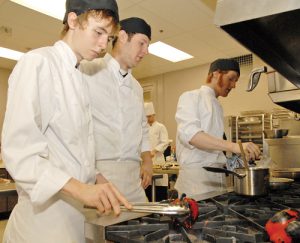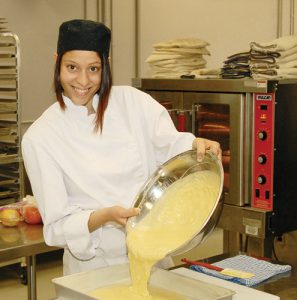
Labour shortage prompts new curriculum
Much like a band saw, education is cyclical.
With 23 years of experience at Danforth Collegiate and Technical Institute, hospitality and tourism teacher Jean Childerhose has seen many trends come and go, only to return again.
The curriculum leader of technological studies said when she entered teaching in the 1970s skilled trades were very much in demand. But when the ’80s and ’90s came around trades became “second-class citizens”.
The Conference Board of Canada estimates Ontario will be short 364,000 skilled tradespeople by 2025, which means the demand for trades is experiencing a renaissance.
“Now there is a resurgence because they’re discovering there is a need to fill trades that are retiring, and there is nobody taking it on,” Childerhose said. “What we try to do is promote it as a viable option instead of university.
“A lot of people think, if you can’t get into university this is your second choice, and we’re saying it’s equal but it’s different.”
The conference board notes at-risk youth and high-school dropouts as the greatest untapped resource against labour-force woes. The board reported in 2005 that 74,800 students left high school without obtaining a diploma.
In response, the provincial government has launched several programs to try and solve Ontario’s potential labour shortage.
The Ministry of Education has introduced Specialist High Skills Majors, which allows youth to explore 14 economic sectors — including agriculture, hospitality, horticulture, construction, manufacturing, emergency services, mining, forestry and transportation — through in-class learning and co-op.
Danforth Tech has the hospitality and tourism high skills major at the school, and it ties in well with the Ontario Youth Apprenticeship Program it already offers.
Students take two co-op courses, an English, a math and a science course that relates to the hospitality sector.
On top of the regular curriculum, students acquire their certifications in Smartserve, first aid, service excellence as well as Public Health Food Handlers Permit and WHMIS training.
“Basically what they get with that is they get a special seal on their diploma, but they also have more to take to an employer, to someone they want to get an apprenticeship with saying, ‘Hey, this is what I come with’,” Childerhose said.
Education Minister Kathleen Wynne said the benefits of the three-year-old program have already been felt.
In 2006–2007 there were 228 students involved in the construction specialist high skills major in 2008-2009 there were 1,711 students, she said. Additionally, there were 155 students in the manufacturing specialist high skills major program in its first year and by 2008-2009 there were 1,448.
“So you can see the interest is just huge, and in Toronto in 06–07 there were no specialist high skills majors,” she said. “They’ve really expanded over the last few years, and these are programs that we fashioned in order to keep kids engaged in school, particularly kids who wouldn’t necessarily complete high school.”

It’s also a step towards the ministry’s goal of 85 percent high school graduation rates for the province.
“It’s a really significant increase,” Wynne said. “I think what we are seeing in our secondary schools there’s a real cultural shift, there’s an understanding of the importance of this kind of learning and when we see that our graduation rate has gone from 68 percent to 77 percent of students I attribute a lot of that to this kind of program.”
Training, Colleges and Universities Minister John Milloy sees students fall under his purview once they graduate from high school.
At present his ministry is working on creating the Ontario College of Trades, a regulatory body similar to the Ontario College of Teachers.
Still before the legislature, the college will modernize the province’s apprenticeship and skilled trades programs and keep all decisions within the hands of skilled trades.
“There’s some very stark demographic realities right now about retirement rates and the fact we don’t have enough young people going into the skilled trades,” Milloy said. “With infrastructure, there’s just more demand for more people out there with the skilled trades.”
The only problem is there’s not enough promotion for the trades.
“It is a wonderful profession, it pays well, there’s a demand in many areas and you are a part of the new economy,” Milloy said. “The problem is skilled trades don’t have the profile that they deserve, and not everyone recognizes (that).”
As for the kids, Childerhose has seen plenty of unsolicited dedication from them, but she admits there will always be those who stick with theory and those for practical.
“We have students in the school who will always take academics, and they’re probably pressured by parents, because there’s a lot that only see that option, but the students who are interested in tech are devoted to tech,” she said.
Childerhose points to the students who recently stayed at the school deep into the night to cater a special event, as well the competitions tech-based kids have attended, achieving a gold medal in an auto-mechanic contest and a bronze in baking.
“That’s the kind of enthusiasm we get,” she said.
